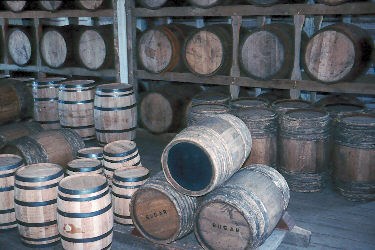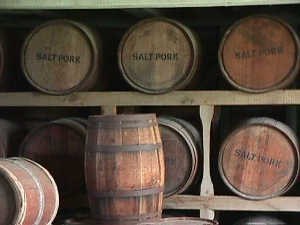
The Commissary Department was in charge of all food or subsistence supplies at a military post. At each post, the storehouses used by the Assistant Commissaries of Subsistence were provided by the Quartermaster Department, and the quality of protection varied from post to post. Many storage areas were old and dilapidated. Often supplies were stored in different buildings far from each other; roofs leaked, and rats got in to gnaw at the foodstuffs and other staples. Although aware of the problem, there was little a Commanding Officer or a Quartermaster could do to eliminate the situation, until funds were provided for new warehouses.
New storehouses were a source of pride to harried Commissaries, who could sleep at night assured their stores were secure. The Commissary at Fort Scott was fortunate, for as soon as the Quartermaster Storehouse was completed, he was assigned a large room on the first floor with a loft above and basement below. To ensure against theft, locks for the storerooms were ordered.
Army regulations provided that there would be one Assistant Commissary of Subsistence, with one clerk, at each post; but this position often was combined with that of the Assistant Quartermaster, so that one man acted as both. At Fort Scott, where the construction program was under full swing, the jobs were separate until 1846 when the positions were combined after many of the soldiers, including Captain Swords, left Fort Scott to serve in the Mexican War. 
Subsistence supplies were divided into two parts: subsistence stores, consisting of rations, such as pork, flour, coffee, candles, etc., and commissary property, which was the necessary means of issuing and preserving these stores, such as stationary, scales, measures, tools, etc.
In the early nineteenth century, the component parts of rations consisted of: three-fourths of a pound of pork, or one pound and one-fourth of fresh beef, or one pound and one-fourth of salt beef, or twelve ounces of hard bread, or one and one-fourth pounds corn meal, and one gill of whiskey.
For every one hundred rations, the men were provided four pounds of soap, one pound and a half of candles, two quarts salt, four quarts vinegar, and twelve quarts peas or beans. The rations remained relatively unchanged until 1861, except for the addition of ten pounds of rice or hominy, ten pounds of green coffee, or, eight pounds of roasted (or roasted and ground) coffee, or, one pound and eight ounces tea, fifteen pounds of sugar, and pepper, potatoes, and molasses.
Whiskey remained a part of the men's rations during most of the Nineteenth Century, although attempts were made to eliminate it from the diet. At Fort Scott, Major Graham was happy to note that his men had signed a temperance pledge, and the barrels of whiskey on hand were returned to the Quartermaster Storehouse at St. Louis to be sold. The temperance movement, however, was never entirely successful.
Spoilage of items was common, and salt meats and flour had to be inspected before they could be accepted. Because different foodstuffs required different storage, the Commissary usually stored his spirituous beverages on the first or basement floor, salt port, beef and other supplies on the second, and the cereals on the third.
Apparently the Commissary at Fort Scott kept fairly large amounts of rations on hand, probably because of the uncertainty of delivery. In August 1844, Hoskins reported that he had not received the full shipment that had been contracted for with Turnham & Arthur; nevertheless he had on hand 663 gallons of vinegar, 58 ½ bushels of salt, 3600 pounds of soap, and 114 ½ bushels of beans. The Lieutenant voiced a complaint common on the frontier, when he wrote that the "balance of the articles delivered on the Contract being of a quality entirely inferior to that required by the Contract" had had to be rejected.
Some allowance for the quality of the items received was made because the heavy rains had washed out the roads preventing early delivery. Hoskins had received one lot of sugar and coffee from Major Lee, another contractor. Until a delivery of pork was made in September, bacon was issued to the men. The hot prairie sun made even the candles melt, and the contractor had supplied the post with candles "very nearly as soft as hog's Lard." To remedy the latter, Hoskins urged that 1000 pounds of good hard candles be delivered as soon as possible.
By 1846, it became difficult to obtain beef, the staple of the soldiers' diet. Cattle were scarce because General Kearny was buying beef for his expedition to Santa Fe. As traders from Missouri bought all the cattle they could find at exorbitant prices to take to Fort Leavenworth, the bids at Fort Scott came in either too high or from unreliable bidders. Prices rose from six cents to ten cents a pound. In May, the Commissary began issuing whole beef at a time to the troops, but this was objectionable because of the difficulty in preventing spoilage of such large amounts of meat. Officers were allowed to buy food from the Commissary and other items that were standard to the rations of the period, even though there was a Sutler at Fort Scott. Returns list purchases of flour, ham, beans, rice, coffee, sugar, vinegar, candles (both sperm and star), soap and salt. Any luxuries, however, could be obtained only at the Sutler's Store.
The Commissary, himself, also made a number of purchases from the post Sutler, H. T. Wilson, indicating some effort to provide variety in the diet. His purchases included corn meal, black pepper, two quarters of mutton, raisins, matches, butter, milk, three pounds of nails, three tin buckets, saleratus, 66 ½ pounds of ham, two stone jars, and three brooms. He also purchased 1037 ¾ pounds of fresh beef from W. C. Horner for eight cents a pound.
When Captain Cady became Assistant Commissary of Subsistence, he found that most of the flour, including 70 barrels furnished by the contract of 1850, was unfit for issue. Cady observed that the flour had not been dried sufficiently when packed, and the barrels had not been seasoned, although perfectly good in all other respects. Pork had been packed in barrels that had lost part of their brine, which made the top layers, at least, unfit for issue. Captain Morrow, who had been ill some time before his death, had not been able to care for his stores, and Cady now found himself responsible for them. When spoilage occurred, the Commissary was required to separate and repack the good and submit the rest to a Board of Survey.
Often spoiled meat and flour were sold to neighboring Indians or to settlers, who otherwise had no means of obtaining needed staples. Empty barrels and containers were saved to be sold to settlers, emigrants, or contractors who had need of them. An interesting use of the lead linings of the "tea-caddies in the commissary" was related by Lowe, who wrote the linings were used to make the coffin of a dead major airtight.
The commissary property had to be accounted for also. A requisition from the Commissary at Fort Laramie in 1849 lists the following items as needed:
· One Platform Scale &Weights · One Patent Counter Scales · Two Prs. Tin Scales (one large) · Two Sets Iron Weights · Two Sets Tin Measures · One Set Wooden Measures · One Molasses Gate or Patent Spring Faucet · Six Patent Faucets for Whiskey, Vinegar, etc. · One Meat Ax · One Meat Saw · One Meat Cleaver
Although there were three platform scales on hand, one in the root house and two in the issue room, a later Commissary sent in a requisition for a fourth to use in the receiving storehouse. Due care had to be taken that the rations were issued in the correct amounts, so that supplies did not run short before a new consignment arrived and so the men did not complain of shortages at mealtime. The emphasis on proper weighing scales may be due also to the fact that the Commissary could have deductions from his salary, if the supplies were short.
The information for this section was taken from the Historic Furnishings Report for the Quartermaster Storehouse at Fort Scott by Sally Johnson Ketcham.
|
Last updated: July 29, 2016

